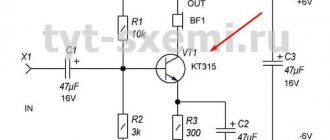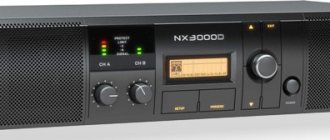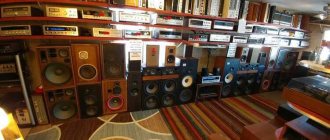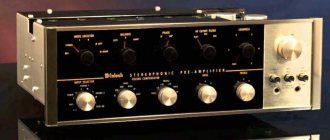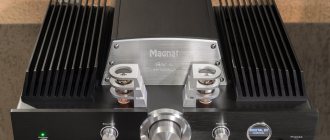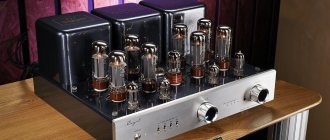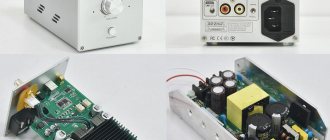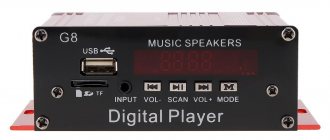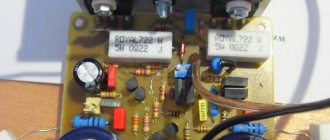The Magnat company can hardly be called a newcomer to the audio market, but from time to time it surprises with its courage - it takes on directions completely unknown to it. And he succeeds.
The Bulldog is a good-natured but unyielding dog. It was the bulldog's muzzle that graced the Magnat logo from the very beginning of its existence (although ten years ago the bulldog left the logo). The company was founded in 1973 in Cologne by engineer-enthusiast Rainer Haas and the number of his employees at that time did not exceed 60 people. During the 70s, Magnat became one of the leading manufacturers of speaker systems, and in 1983 it entered the Car Audio market. Automotive electronics are something the brand has long been associated with, but in 2007, the peace of hi-fi players was disturbed by an unexpected debut.
Tube debut
The Magnat RV 1 push-pull amplifier inherited all the best from the tube classics of the 60-70s. The topology was based on low noise 12AX7EH dual triodes and 12AU7 tubes in the pre-section, as well as EL34 pentodes in the output stage. There was even a MM/MC corrector for 4 12AX7EHs. The idea of developing a full-fledged tube amplifier was suggested to the designers by Audiovox export manager Mario Lode, who was in love with the AC/DC group. The RV 1 was followed by the successful 50-watt amplifier RV 2 with carefully selected pairs of dual driver triodes 12AX7 (ECC82), 12AU7 (ECC82) and 6550 output tetrodes. It is noteworthy that all amplifier tubes were manufactured in Saratov.
The first hybrid tube-transistor amplifier from Magnat - RV 1, was produced from 2007 to 2012
Another bold decision by the Magnatists was the idea of introducing a preliminary circuit with dual triodes ECC88 (6922) into the output circuits of the SACD player, which led to the creation of the MCD 850 model with a Burr-Brown PCM1796 DAC and an R-core transformer in the power supply . The 6922 dual triodes do not act as amplifiers here, but are responsible for impedance conversion, allowing for a low output impedance. The same applies to the MCD 1050 CD player, which uses similar tubes. The model is equipped with an upsampler, a Burr-Brown DAC and can work as an external DAC with S/PDIF and USB inputs (24 bit/192 kHz).
Magnat RV 3: listen for hours
For the 40th anniversary of Magnat in 2013, the flagship RV 3 appeared (its review on the website is Virtuoso Warrior. Magnat RV3 amplifier). Sandro Fischer, R&D Director, comments: “We actually discussed all possible options, including pulse amplification. At some point, a decision had to be made, and here the personal love for lamp technology of one of our managers played a role. But we had no illusions about tubes: they, just like transistors, can make both good and bad sound. We like the hybrid design where the tube is used in the preamp. Perhaps it determines only 20% of the sound character, but the equipment with small-signal vacuum devices turns out to be simple and reliable, and if everything is done correctly, it is pleasant to listen to music for hours. And for us this is one of the most important criteria.”
Hybrid tube-transistor amplifier Magnat RV 3
The RV 3 model has become the absolute embodiment of the “hybrid” concept in the company’s lineup. The amplification at its input is carried out by the SRPP section (cascade with dynamic anode load), which has negligible distortion and high linearity. It uses a pair of Russian-made ECC82 dual triodes carefully selected according to their characteristics, which ensures perfect channel identity with minimal variation in characteristics. The discrete output of RV 3 is assembled using high-current Toshiba transistors. The open design of the model is made in an industrial style and looks similar to the engine of the American muscle cars that the company's chief, Shandro Fisher, likes so much. The fan-shaped fins of two cooling radiators symmetrically located on the top panel resemble the needles of a bristling hedgehog. ECC82 are also installed there, surrounded by protective ring turrets, a casing with a 650 W toroidal power transformer and a cylinder hiding a set of power supply capacitors.
Hybrid tube-transistor amplifier Magnat RV 3 (rear view)
The RV3's 8mm milled aluminum panel is bisected by a highly polished ALPS motorized volume attenuator knob, also made of aluminum. On the left side of the facade there is a power button and a balance control, on the right there is an input selector on reed relays, a round OLED display showing the input, and a headphone jack. The amplifier produces 150 W per channel (8 ohms), and the high damping factor allows it to work with virtually any speaker. You can control the RV 3 using a metal remote control.
Magnat RV 3 hybrid tube-transistor amplifier, ECC82 tube (left) and aluminum remote control (right)
The advantages of the hybrid design are that the tube pre-stage helps achieve natural analog sound, and the transistor output provides stability, accuracy, dynamics and allows you to be more loyal to the choice of speakers. RV 3 vacuum triodes have a linear transfer characteristic, short harmonic spectrum and high input impedance, which helps optimize the amplifier's input impedance. As a result, it is possible to obtain a natural tone of sound, woven into the pattern of the characteristic sound delivery of modern amplifiers with a powerful transistor “exhaust”, guaranteeing an accurate and dynamic sound. By the way, Sandro Fischer is convinced that it is tube technology that will become a “bait” for young people, since even compressed files passed through a triode acquire charm and nobility.
Are we rocking?
The design of the amplifier somehow naturally invites you to turn on “Thunderstruck” AC/DC and instantly go into the lead, completely forgetting about watts, decibels, stage and detail. With all this, looking at the amplifier, you subconsciously expect a thick, dark and bassy sound, saturated with the corresponding tube overtones. In fact, Magnat RV 4 sounds completely different. There is no talk of any thick and fat “tube” bass. There is little bass and it sounds neat. In general, the amplifier plays collectedly and accurately, with good acoustic control even in difficult moments. There is no trace of boominess, coloration or laxity.
For those who haven't figured it out yet, this is a Stereophonic Amplifier.
I didn’t have any branded acoustics of the appropriate class at hand, so I listened to this amplifier with 2 pairs of floorstanding speakers from completely different brands: Piega Classic 7.0 and Legacy Audio Classic HD. In both cases there was a feeling of an early decline in the edges of the spectrum, and there was little lower bass, and the very top sounded somewhere in the distance. With all this, I note that the amplifier controlled even the Legacy speakers, which were very difficult to control.
Power button?! And it seemed to me, Engine Start
As the main property of the amplifier, I would note a very expressive and solid midrange. Thanks to this, live instruments sound truly temperamental. So, for example, the timbres of Arkady Shilkloper’s horn are conveyed very naturally and close to reality, and the expressive manner of performance fascinates from the first notes. With any well-recorded music, attention is immediately focused on the artistic component of the work, and this is a fundamentally positive quality for any Hi-Fi component.
Turned alloy control knobs rotate smoothly, and the weight is felt
It is interesting that the amplifier does not have any pronounced accents or tangible colors in the mid-frequency region. I would rather classify the tonal balance as neutral. The effect of live sound is achieved by the most common and literal method: an even frequency response, the highest resolution and good dynamics.
The V-shaped placement of the speaker terminals is not just beautiful. It becomes better to see where the plus and where the minus are, and it’s even more convenient to twist them
Going through music of different genres and dispositions, I once again made sure that a good amplifier plays everything perfectly. AC/DC and ZZ Top were, as expected, cheerful, energetic and energetic. You could listen to Katie Melua's voice and, starting with the first composition of the album, come to your senses only after stopping the disc. The beloved classical and jazz recordings did not disappoint. The more beloved Amon Amarth not only sounded as true and intelligible as possible, but also brought a lot of horror, which is completely reasonable, taking into account the theme of the songs and the corresponding manner of performance.
A luxurious amplifier runs on Russian tubes - this is a reason to be proud!
The final test was the 1st album by Guru Groove Foundation. Each audio system emphasizes something of its own in this recording. In some places this disc sounds like 100% electric music, and in some places you can hear live energy, and you can realize that in fact these are not sampled sounds, but live musicians, the sound of whose instruments have been passed through digital microprocessors. In the case of the Magnat RV 4, the sense of life in the recording was clearly audible. The large composition “Call me Up” sounded very rhythmic, integral and spacious, with lively and expressive vocals, an indescribable number of timbres, complex and fascinating intonations.
Hybrid democracy
German engineers also succeeded in implementing the idea of hybrid designs in the classic Hi-Fi line of amplifiers (MA400, MA600, MA800, MA1000) and even in more “democratic” models - the MC 2 audio system, the MC 20 CD receiver and the MC 1 SACD receiver.
The tube-transistor MA 1000 with a power of 80 W per channel has a more traditional design, unlike the RV 3. Its pre-stage is built on two dual ECC82 triodes that have undergone a 60-hour factory warm-up. The output contains Toshiba transistors. The power supply unit has 4 electrolytes of 10,000 μF each and a toroid. In combination with the MA 1000, we recommend the MCD 1050 CD player that matches its parameters.
Hybrid tube-transistor amplifier Magnat MA 1000 (with cover removed)
The MA 800, MA 600 and MA 400 amplifiers use a similar tube-transistor base. The MA 800 integrated circuit differs from the MA 1000 in power (2 x 75 W at 8 Ohms), has a topology of circuits such as “dual mono”, “pre” on ECC82 lamps and an output on high-current Sanken transistors. Each channel is powered by a separate winding of a toroidal transformer. The aluminum panel features tube windows and the same controls as the MA 1000. The circular OLED display features a pair of indicators to indicate the use of one of the MM/MC phono inputs. The MA 800 model has similar switching, but does not have a preamplifier output.
Two ECC82 tubes on the input stage of the Magnat MA line of Hi-Fi amplifiers
The younger “hybrids” MA 600 (2 x 55 W, 8 Ohm) and MA 400 (2 x 32 W, 8 Ohm) have a different design, use only one ECC82 lamp in the pre-stage and also have a semiconductor output. The MA 600 has a built-in Burr-Brown DAC and a Bluetooth module with aptX support for lossless formats. There is a full range of analog and digital inputs, including MM phono jacks and an asynchronous USB port (24-bit/192 kHz). The closing MA 400 series received an MM phono preamplifier with low-noise op-amps and an infrasound filter. The power supply has two 10,000 µF capacitors.
CD player Magnat MCD 1050 with tube preamplifier
The Magnat line includes the MC 20 hybrid CD receiver with one ECC88 tube in the input stage and Thomson Audio chips in the output stage. The model is assembled in an aluminum case with wooden sides, has a CD drive, an AM/FM tuner with RDS and advanced switching, including a USB port, mini-input jack, subwoofer output, etc. The built-in amplifier develops 30 watts per channel. The MC 2 kit is available, including the MC 20 and two bookshelf speakers. Hybrid SACD receiver MC 1 with a power of 2 x 60 W, is equipped with a similar lamp at the input, and has Sanken transistors at the output.
Hybrid CD receiver Magnat MC 20
Magnat's focus on hybrid amplifiers has brought it well-deserved success. Currently, Magnat produces components for Car Audio, DC, Hi-Fi and is even setting up the production of headphones - judging by the latest data from a test laboratory in Pulheim-Brauweiler near Cologne. This bulldog will teach the young people new tricks.
System
Before starting to listen to the system, I made a simple comparison of two connection methods - analog and digital. The source was a very decent and respected Moon CD player. It would seem that the situation is obvious - use the analogue and don’t think! But after several tests, I still preferred the digital connection.
Two pairs of high-class floorstanding speakers helped us understand how the Magnat RV4 plays
The combination of Moon and Magnat gave, although beautiful, a cloyingly soft, viscous sound, which obviously lacked focus and clarity, especially on high-spirited and energetic music. The amplifier's integrated DAC made sounds clearer, more defined, and provided the best attack, sharper and more prominent high frequencies. The choice was made in favor of the latter option (as more universal), so the player served as a digital transport.

